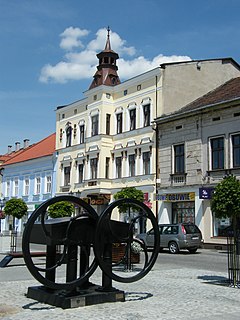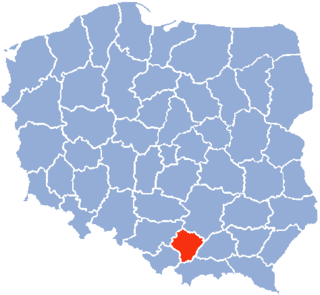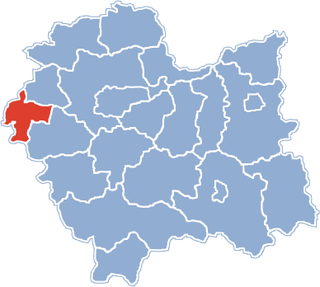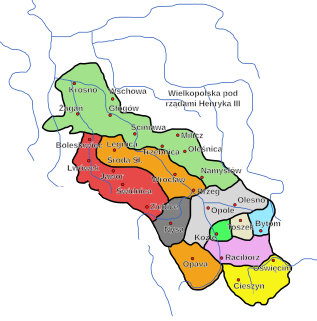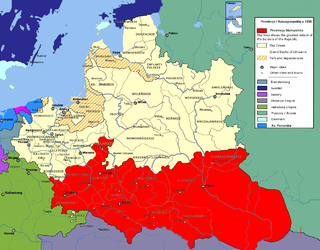

Silesian County (Polish: powiat śląski) was an administrative unit (powiat) of both the Kingdom of Poland and the Polish–Lithuanian Commonwealth. With seats in the towns of Zator and Oświęcim, it was part of Kraków Voivodeship.

A powiat is the second-level unit of local government and administration in Poland, equivalent to a county, district or prefecture in other countries. The term "powiat" is most often translated into English as "county" or "district".

The Kingdom of Poland and the Grand Duchy of Lithuania joined in a personal union established by the Union of Krewo (1385). The union was transformed into a closer one by the Union of Lublin in 1569, which was shortly followed by the end of the Jagiellon dynasty, which had ruled Poland for two centuries.

The Polish–Lithuanian Commonwealth – formally, the Crown of the Kingdom of Poland and the Grand Duchy of Lithuania and, after 1791, the Commonwealth of Poland – was a dual state, a bi-confederation of Poland and Lithuania ruled by a common monarch, who was both King of Poland and Grand Duke of Lithuania. It was one of the largest and most populous countries of 16th– to 17th-century Europe. At its largest territorial extent, in the early 17th century, the Commonwealth covered almost 400,000 square miles (1,000,000 km2) and sustained a multi-ethnic population of 11 million.
Silesian County was created at the General Sejm in Warsaw, in 1564, when King Sigismund II Augustus merged territories of the Duchy of Zator and the Duchy of Oświęcim, incorporating them into the Kraków Voivodeship of the Polish Crown. [1] The kings retained both ducal titles, and names of both duchies remained in common use. It existed for over 200 years, and was dissolved after the third partition of Poland (1795).

Warsaw is the capital and largest city of Poland. The metropolis stands on the Vistula River in east-central Poland and its population is officially estimated at 1.765 million residents within a greater metropolitan area of 3.1 million residents, which makes Warsaw the 8th most-populous capital city in the European Union. The city limits cover 516.9 square kilometres (199.6 sq mi), while the metropolitan area covers 6,100.43 square kilometres (2,355.39 sq mi). Warsaw is an alpha global city, a major international tourist destination, and a significant cultural, political and economic hub. Its historical Old Town was designated a UNESCO World Heritage Site.

Sigismund II Augustus was the King of Poland and Grand Duke of Lithuania, the only son of Sigismund I the Old, whom Sigismund II succeeded in 1548.

The Duchy of Zator was one of many Duchies of Silesia.
The total area of Silesian County was 2690 sq. kilometers, and initially consisted of four royal towns (Wadowice, Kęty, Oświęcim and Zator) and one private (Żywiec). In the second half of the 16th century the largest of them was Kęty, with over 1000 inhabitants [2] . Of 188 villages, 38 had over 200 inhabitants [3] . In 1617 a new private town of Zebrzydów, now Kalwaria Zebrzydowska, was founded. In 1723 town rights were granted to Biała, now part of Bielsko-Biała. The town was in the centre of a small German language island that consisted of several other villages. The rest of the County was inhabited by the vast majority of Polish Roman Catholics, although at the turn of the 17th century the county had the highest share of Protestants in the Kraków Voivodeship: 29% of the total number of churches were protestant (mostly reformed), they were present in 34 parishes and their number was estimated at 10 – 15 thousand [4] .

Wadowice is a city in southern Poland, 50 kilometres southwest of Kraków with 19,200 inhabitants (2006), situated on the Skawa river, confluence of Vistula, in the eastern part of Silesian Foothills. Wadowice is best known for being the birthplace of Pope John Paul II.

Kęty is a town in Oświęcim County, Lesser Poland Voivodeship, Poland with 18,955 inhabitants (2012). The town located in Silesian Foothills dates its earliest document from 1277 when Polish prince of Opole Władysław confirmed sale of the settlement and adoption of Lviv city rights. The town's name comes from the word kąt. The greatest development of the town came under the rule of Jagiellons, when the town became royal property.

Żywiec is a town in south-central Poland with 32,242 inhabitants. Between 1975 and 1998, it was located within the Bielsko-Biała Voivodeship, but has since become part of the Silesian Voivodeship.
The largest Jewish community lived since the late 16th century in Oświęcim, when they established the first Qahal, built a Synagogue and opened a Jewish school [5] . In years 1747–1749 the deanery of Oświęcim counted 2462 Jews [6] .
The Qahal was a theocratic organizational structure in ancient Israelite society according to the Hebrew Bible. In later centuries, Qahal was the name of the autonomous governments of Ashkenazi Jews until being abolished in the 1840s.

A synagogue, is a Jewish or Samaritan house of worship.

